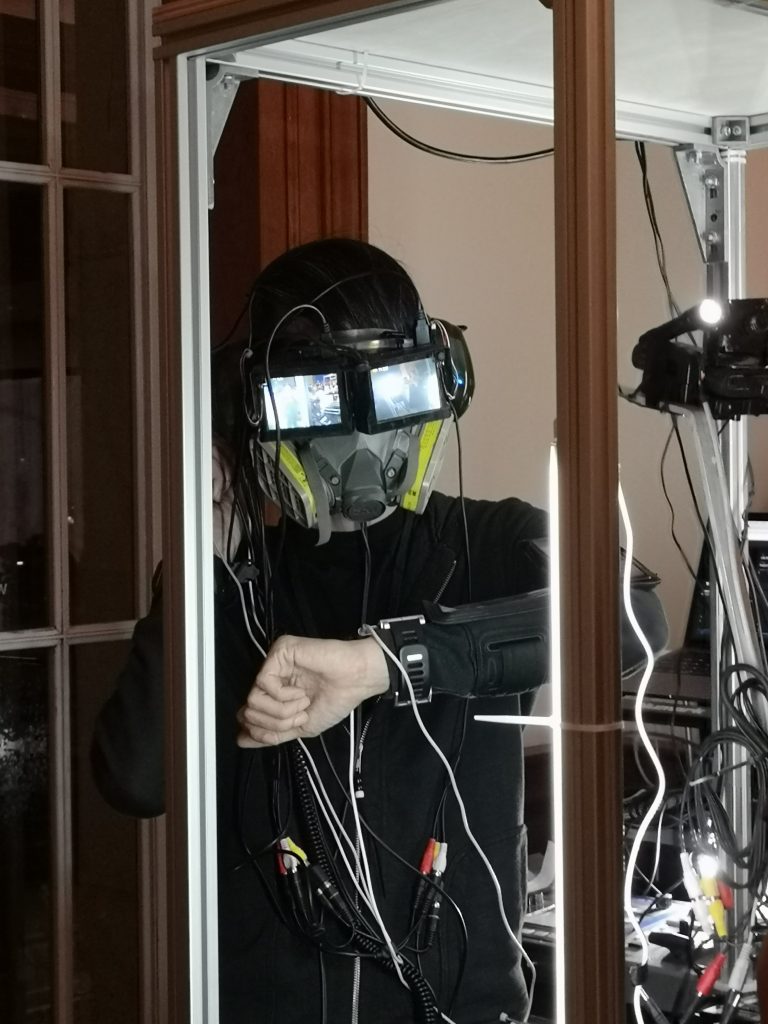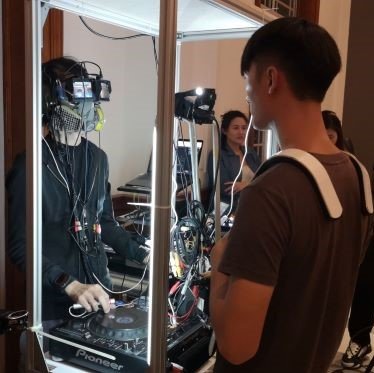
On 22 and 23 August, collaborative INTER-MISSION showcased their artwork: Life Circuit: I/O, which incorporated Lee Kang-so’s Disappearance, Bar in the Gallery (1973) at National Gallery Singapore. The work showcased 2 parts, which lasted throughout the 2 days.
The first part showcased one of the artists wearing a headgear that covered his whole face, and wherever he moved, the device would send sound feedback which acts as a recording of his movements.
The second part showcased the artists and 4 dancers. One of the dancers was wearing a contraption that recorded himself and also projected that exact recording in real-time. The other dancers all had phones with them that were on a video call, and they danced around the scene, with the phone recording their actions as well. These videos were then combined and put onto 1 projector screen at the front of the exhibition. One of the artists (the one who was wearing the headgear on the first day) played the sound recordings that were received on the first day. After a while, the dancer passed the contraption to the audience to let them try out the projection. The performance ended when the artist wore the contraption and stood in front of the artist who did the sound feedback.
Videos
They adapted Lee Kang-so’s Disappearance, Bar in the Gallery (1973) by making the performance venue seem like an olden food stall, with wooden benches and tables set-up. The audience could buy food and drinks while enjoying the performance.
The concept behind Life Circuit was to provide an alternative reality to which the audience observes the artist record his movement and perception of the exact space that the audience is sitting in. The use of technological products highlights their experiments and explorations of intersections between video art, music and performance.
There is consistency within the Life Circuit works that are done by INTER-MISSION, in terms of the materials that they use – reconstructed industrial headgear, such as welding goggles, gas mask, and earmuffs, as video and audio wearable gadgets. Also in how they conduct their experiments, having one performance that is the input of the space, and the other performance being the output. However, the difference is the interaction between the artists and the audience, and how responsive the audience is to the artists’ feedback. The second performance involves the audience’s reactions and participation, giving the work more personalization where the audience’s perception of the space is recorded on the big screen.
Using Lee Kang-so’s Disappearance, Bar in the Gallery (1973) emphasized on the warped reality that the space provided to the audience. When I stepped into the performance space, it was no longer an open space in a gallery, but a small cafe setting and the artist’s mapping the space using their devices was a mapping of the cafe setting and not the gallery. It brought the audience to experience a certain memory that the artists had, even though it may be personal but still resonated within the audience. The atmosphere was less tense, with the presence of benches and tables, for the audience to sit around and interact.
The first day showcased the artist’s impression of the space and his impression of the reality seen through his goggles, which were 2 smaller screens that showcased what he ‘sees’, even though he could not see anything. The sound feedback was then used as a recording of his perception of the space later in the second performance, which was played as a contrast to the current group of people who were recording their perception of the same performance space through a video call. In addition, pure impressions from the audience were also recorded when they walked around with the contraption and it varied depending on how long they wore the contraption.
This work showcased the impressions of different people about the same space, while each person who were in this performance, audience included had a different reality and impression of the performance etched on their mind. Contrast was shown through the live video feedback of the dancers and the participants, with the sound feedback that was the artist’s impression. The reality differs where in the first performance the artist was not able to see or sense his surroundings and just walked around blindly, using sound as the feedback, while in the second round the audience and dancers could see what they were doing, or where they were going, thus they had more control over which direction they wanted to step towards, or the obstacles that were in front of them. The audience who sat around also had a different perspective as they had a view of the whole scene and what was happening to each party, they also had the choice to leave whenever they want or to stay throughout the whole duration.
It was interesting to watch the different perspectives that different people could provide about the same scene and the same performance. Although all of us were at the same scene at the same time, the different impressions created during that span of time was extremely unexpected (from the artists who knew what they were doing, and from the audience who had no idea what was going on). It also showed how technology can be used to show the tangibility of something psychological.
Resources
https://inter-mission.art/About
“Disappearance”: Lee Kang-So’s 1970s works at Gallery Hyundai, Seoul – original interview extract
http://www.teowyuehan.com/life-circuit-40
https://artsequator.com/event/life-circuit-by-urich-lau-and-teow-yue-han/2019-08-22/

